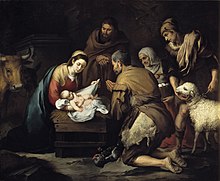Adoration of the Shepherds




The adoration of the baby Jesus by the shepherds , or in short: adoration of the shepherds , has been a popular motif in Christian art since the Middle Ages . It is to be found first in illumination and in cathedral sympana ; later also in frescoes as well as on panel and canvas paintings. Represented Mary , Joseph , the lying in the crib or on straw or blankets baby Jesus , angels and in the background often ox and donkey ; from the side a more or less large group of simply dressed and mostly unshaven men with shepherd's staff , shepherd's bag, bagpipe , flute, etc. appears - sometimes sheep can be seen in the background.
Bible text
The motif goes back to the Christmas story in the Gospel of Luke ( Lk 2.8–20 EU ), where it says:
- “In that area, shepherds camped in the open field and kept watch over their flock by night. Then the angel of the Lord came to them and the splendor of the Lord shone around them. They were very afraid, but the angel said to them, Do not be afraid, for I tell you a great joy that will be shared with all the people: Today the Savior has been born to you in the city of David; he is the Messiah, the Lord. And that should serve as a sign: You will find a child wrapped in diapers and lying in a manger. And suddenly there was a great heavenly host with the angel, which praised God and said, "Glorified is God on high, and on earth there is peace with men of his grace." When the angels had left and returned to heaven, the shepherds said to one another: Come, we are going to Bethlehem to see the event that the Lord had proclaimed us. So they hurried and found Mary and Joseph and the child lying in the manger. When they saw it, they told what they had been told about this child. And all who heard it were amazed at the shepherds' words. But Mary kept everything that had happened in her heart and thought about it. The shepherds returned and praised God for what they had heard and seen; because everything was just as they were told. "
meaning
While Matthew's traditional adoration of the kings places the Christ child above or at the side of high-ranking or educated people (kings, magicians, astrologers, etc.), Luke includes people from the common people in his Christmas story - in other words: the Jesus child is there for everyone or has something to give to everyone. In addition, the 'Adoration of the Shepherds' - in contrast to the 'Adoration of the Magi' - also contains idyllic - pastoral elements that were often depicted in painting.
Representations
The earliest representations of the shepherds from the Christmas story in Christian art can be found in book illuminations (e.g. in the Hortus Deliciarum of Herrad von Landsberg ) or at Tympana (e.g. at the Cathedral of Chartres ), whereby the actual subject of the representation is the 'birth of Christ' and the shepherds are only to be seen as decorative accessories. Only later did the 'Adoration of the Shepherds' emancipate itself as an independent pictorial theme, as opposed to the 'Adoration of the Kings'. The previous ' Annunciation to the Shepherds ' was treated as a separate subject from the start, but it was shown much less frequently. In rare cases, the 'Annunciation to the Shepherds' and the 'Adoration of the Shepherds' (sometimes the ' Adoration of the Magi ') are combined in one picture. The later depictions of the 'Adoration of the Shepherds' mostly belong to the art-historical type of night pictures - i. H. either the angels or the baby Jesus act as a light source.
Shepherds in the king portal of Chartres Cathedral (around 1145/50)
Hortus Deliciarum
(around 1180)Duccio di Buoninsegna
(around 1310)Giotto di Bondone
(around 1320)
See also
literature
- Stephan Waetzoldt: Drei Könige , in: Reallexikon zur Deutschen Kunstgeschichte , Vol. 4, 1955, Sp. 476–501




